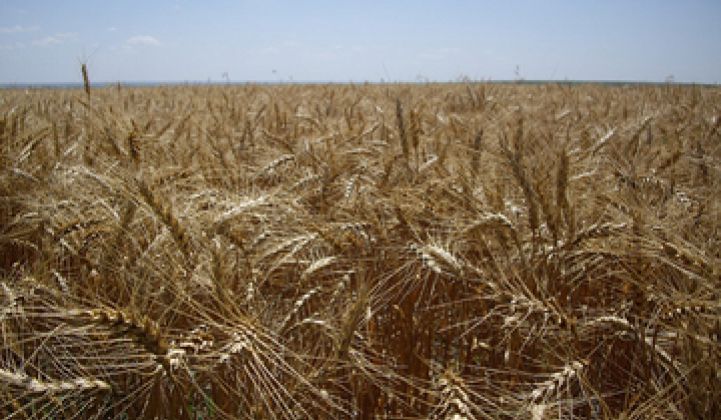People worldwide are watching helplessly as food prices rise. According to the Food and Agriculture Organization (FAO) report Agricultural Outlook 2011-20, rising food prices and market volatility are here to stay. World Bank Group numbers presented in April 2011 show that global food prices are 36% higher than they were a year ago and remain close to the 2008 peak.
Food prices are soaring due to export restrictions, low global stocks, increasing use of biofuel, higher fuel costs due to unrest in the Middle East and North Africa, and severe weather conditions, among other reasons. To meet the demand -- if the predicted 2050 world population of nine billion is correct -- we’ll have to increase world food production by 70%. To achieve that, good weather throughout the planting season is essential. Some observers estimate that if the weather this planting season won’t resemble the last year’s, we could produce more food. But according to the article "Crop-Climate Models Need an Overhaul" (to be printed in the July issue of Nature Climate Change; published online on June 19, 2011), estimates on how much food we can grow in a warmer world are out of date.
Worldwide Data on Crops Needed
ReimundRötter (MTT Agrifood Research Finland), Timothy Carter (Finnish Environment Institute SYKE), JørgenOlesen (Aarhus University) and John Porter (University of Copenhagen) participate in the Agricultural Model Intercomparison and Improvement Project (AgMIP), coordinated by NASA/Goddard Institute of Space Studies. They argue that many of the current crop-climate models used to estimate the potential impacts of climate change on food supply, developed 20 years ago, are outdated.
For example, these models don’t incorporate the latest knowledge about how crops respond to a changing climate with more hot days. The researchers’ field experiments showed that when the temperature exceeds 86 to 96.8 degrees Fahrenheit during flowering, crops (such as wheat, maize and rice) “experience a sharp decline in grain set and yield.” Based on this discovery, many forecasts tend to overestimate how much can be grown in the regions that will be affected by hotter weather during the growing season.
Instead, the writers argue, crop-climate models should focus on “multi-model ensemble techniques” and not rely on a single model, to improve assessments and information, of “outmost importance in managing the risks and moderating the influence of climate change on future crop productivity.” They continue: “In terms of research, we should start by reviewing existing models to see where the big deficiencies are in understanding crop growth and development processes.” To create more precise models, they cite the need to compile high-quality field data for “model testing at the scale of whole farms’ and high-quality data sets for each major crop type."
The figures of the USDA’s report on world agriculture indicate similar results, as observed by the Nordic researchers: weather conditions are impacting the world's food supply. Due to recent cold snaps in the U.S., corn stocks have diminished from 1.7 billion bushels in 2009 to the 695 million bushels projected in June 2011, according to the press release from ActionAid USA. The group states that its experts have warned that this decline is a result of climate change. “Diminishing corn and soy stocks, revealed in the USDA report, also come from increasing demand for cereals for food, feed and biofuels,” said Marie Brill of ActionAid USA.
Fighting the prices
The problems the food market is facing didn’t go unnoticed only by the people, who in some parts of the developing world have rioted against increasing food prices, but also by government officials and world leaders.
Rising prices may not affect the developed world as much as poorer countries, where people are forced to spend most of their wages on food alone. According to the World Bank’s Food Price Watch, an additional 10% increase annually could drive 10 million more people below the $1.25-a-day poverty line. Agriculture ministers of the group of 20 countries (G20) that are meeting in Paris this week hope the ambitious projects and aims would stabilize and sustain food supplies.
French Agriculture Minister Bruno Le Maire ascribed the present food crisis to changing weather conditions, such as floods in Australia, lack of rain in Western Europe and 2010’s Russian drought, which disrupted food production and contributed to price volatility. According to Reuters, Le Maire was making back-to-back phone calls to his G20 peers to win unanimous support for his proposals. He’d like to improve market transparency; initiate global policy coordination to tighten commodity markets rules; set up a database to coordinate world food stocks that would help the governments foresee the likely shortages; and reduce government interference in trade to limit trade bans such as the wheat export ban that Russia implemented last year.
Le Maire’s ambitious plan faces obstacles, as China and India are not fond of the proposed Agricultural Market Information System (AMIS) that would collect data on food supplies. As noted by Reuters, AMIS would be launched in June 2011 with FAO. Data collection would start in March 2012 and the first global market outlook and situation update should be released in June.
The effort needed to tackle the food crisis implies no ready solution, due partly to increasing demand for biofuels produced from corn, wheat, soybeans, sugar and vegetable oil and because farmers can’t keep up with demand if the weather is not favorable. Nevertheless, sustainable agriculture technology could ease the global food crisis.



